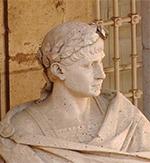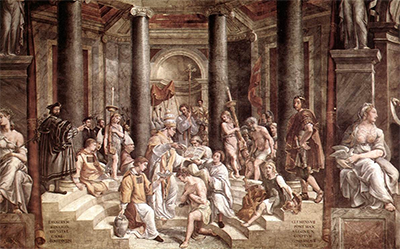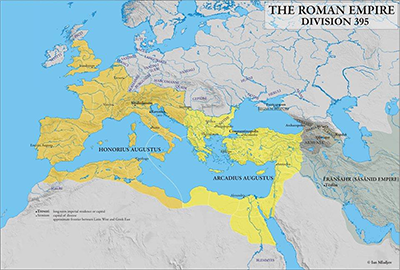The Roman Emperor Theodosius I
Theodosius I was the last ruler of a united Roman Empire, serving in the 4th Century. He is also well-known for declaring Christianity the Empire's state religion. 
He was born Flavius Theodosius in Spain, about 346. His father, also named Theodosius, had a successful military career but then, involved in controversy, had his career and his life cut short. This happened when his son was military governor of Moesia, and the younger Theodosius retired to Spain. Previously, father and son had served together in Britain. Also at this time, the emperor Valentinian I had died and had been succeeded as emperor in the West by his sons, Gratian and Valentinian II; still emperor in the East was Valens. In 378, Roman armies suffered one of the worst defeats in the history of the civilization at the hands of the Goths. The emperor Valens died in the battle at Adrianople. The following year, Gratian appointed Theodosius commander of the Illyrian army and, in effect, ruler in the East. Theodosius set about rolling back advances by the barbarian tribes, with a combination of victory in battle and military alliances borne of promises of settlement. By 381, Theodosius had made peace by overseeing Ostrogoths' settlements in Pannonia and Visigoths' settlements in Thrace; in return, members of both of these peoples agreed to fight for Rome instead of against it. 
In 380, Theodosius received Christian baptism. Later that year, he issued the Edict of Thessalonica, which proclaimed that Christianity was the state religion of the Roman Empire. A major council of bishops met at Constantinople the following year and affirmed the outcomes of the Council of Nicea, which had proclaimed the doctrine that Jesus, the founder of Christianity, was divine. A contender for the main Christian faith at this time were people known as Arians, after Arius, who taught that Jesus was not necessarily divine and one with God. The Council of Nicea had denied these teachings, and Theodosius's council of 381 reaffirmed this denial. Theodosius next had to sort out a period of internecine warfare. In 383, the murder of Gratian accompanied the claim of the Western throne by Maximus. Theodosius responded with force, aiming to restore Valentinian II to his rightful place atop the Western political structure. It took several attempts and several years, but Theodosius defeated Maximum in 388 and had the usurper executed. 
Four years later, unrest again claimed a son of Valentinian I, as the Frankish general Arbogast rose up in rebellion and claimed Gaul and Valentinian II died in the resulting fray. Again came Theodosius to Italy. Again he scored a decisive victory, resulting in the deaths in 394 of both Arbogast and Eugenius, yet another usurper emperor. Theodosius then took the Western throne as well. (He was the last to hold both and is often referred to as Theodosius the Great.) By this time, Theodosius had named one of his sons, Arcadius, as co-emperor in the East. Now that Theodosius was in command of both East and West, he named his younger son, Honorius, as co-emperor in the West. Theodosius died in 395. His sons moved one step up the political ladder, with Honorius becoming the Western Emperor and Arcadius becoming Emperor in the East. |
|
Social Studies for Kids
copyright 2002–2025
David White




